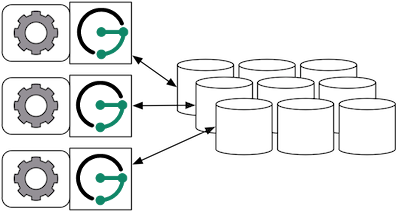Apache HBase

Apache HBase is an open-source, distributed, versioned, non-relational database modeled after Google’s Bigtable: A Distributed Storage System for Structured Data by Chang et al. Just as Bigtable leverages the distributed data storage provided by the Google File System, Apache HBase provides Bigtable-like capabilities on top of Hadoop and HDFS.
HBase Setup
The following sections outline the various ways in which JanusGraph can be used in concert with Apache HBase.
Local Server Mode

HBase can be run as a standalone database on the same local host as
JanusGraph and the end-user application. In this model, JanusGraph and
HBase communicate with one another via a localhost socket. Running
JanusGraph over HBase requires the following setup steps:
-
Download and extract a stable HBase from https://www.apache.org/dyn/closer.cgi/hbase/stable/.
-
Start HBase by invoking the
start-hbase.shscript in the bin directory inside the extracted HBase directory. To stop HBase, usestop-hbase.sh.$ ./bin/start-hbase.sh starting master, logging to ../logs/hbase-master-machine-name.local.out
Now, you can create an HBase JanusGraph as follows:
JanusGraph graph = JanusGraphFactory.build()
.set("storage.backend", "hbase")
.open();
Note, that you do not need to specify a hostname since a localhost
connection is attempted by default. Also, in the Gremlin Console, you
can not define the type of the variables conf and g. Therefore,
simply leave off the type declaration.
Remote Server Mode

When the graph needs to scale beyond the confines of a single machine, then HBase and JanusGraph are logically separated into different machines. In this model, the HBase cluster maintains the graph representation and any number of JanusGraph instances maintain socket-based read/write access to the HBase cluster. The end-user application can directly interact with JanusGraph within the same JVM as JanusGraph.
For example, suppose we have a running HBase cluster with a ZooKeeper quorum composed of three machines at IP address 77.77.77.77, 77.77.77.78, and 77.77.77.79, then connecting JanusGraph with the cluster is accomplished as follows:
JanusGraph g = JanusGraphFactory.build()
.set("storage.backend", "hbase")
.set("storage.hostname", "77.77.77.77, 77.77.77.78, 77.77.77.79")
.open();
storage.hostname accepts a comma separated list of IP addresses and
hostname for any subset of machines in the HBase cluster JanusGraph
should connect to. Also, in the Gremlin Console, you can not define the
type of the variables conf and g. Therefore, simply leave off the
type declaration.
Remote Server Mode with Gremlin Server

Finally, Gremlin Server can be wrapped around each JanusGraph instance defined in the previous subsection. In this way, the end-user application need not be a Java-based application as it can communicate with Gremlin Server as a client. This type of deployment is great for polyglot architectures where various components written in different languages need to reference and compute on the graph.
http://gremlin-server.janusgraph.machine1/mygraph/vertices/1
http://gremlin-server.janusgraph.machine2/mygraph/tp/gremlin?script=g.v(1).out('follows').out('created')
In this case, each Gremlin Server would be configured to connect to the HBase cluster. The following shows the graph specific fragment of the Gremlin Server configuration. Refer to JanusGraph Server for a complete example and more information on how to configure the server.
...
graphs: {
g: conf/janusgraph-hbase.properties
}
scriptEngines: {
gremlin-groovy: {
plugins: { org.janusgraph.graphdb.tinkerpop.plugin.JanusGraphGremlinPlugin: {},
org.apache.tinkerpop.gremlin.server.jsr223.GremlinServerGremlinPlugin: {},
org.apache.tinkerpop.gremlin.tinkergraph.jsr223.TinkerGraphGremlinPlugin: {},
org.apache.tinkerpop.gremlin.jsr223.ImportGremlinPlugin: {classImports: [java.lang.Math], methodImports: [java.lang.Math#*]},
org.apache.tinkerpop.gremlin.jsr223.ScriptFileGremlinPlugin: {files: [scripts/empty-sample.groovy]}}}}
...
HBase Specific Configuration
Refer to Configuration Reference for a complete listing of all HBase specific configuration options in addition to the general JanusGraph configuration options.
When configuring HBase it is recommended to consider the following HBase specific configuration options:
- storage.hbase.table: Name of the HBase table in which to store the JanusGraph graph. Allows multiple JanusGraph graphs to co-exist in the same HBase cluster.
Please refer to the HBase configuration
documentation for more
HBase configuration options and their description. By prefixing the
respective HBase configuration option with storage.hbase.ext in the
JanusGraph configuration it will be passed on to HBase at initialization
time. For example, to use the znode /hbase-secure for HBase, set the
property: storage.hbase.ext.zookeeper.znode.parent=/hbase-secure. The
prefix allows arbitrary HBase configuration options to be configured
through JanusGraph.
Important
HBase backend uses millisecond for timestamps. In JanusGraph 0.2.0 and
earlier, if the graph.timestamps property is not explicitly set, the
default is MICRO. In this case, the graph.timestamps property must
be explicitly set to MILLI. Do not set the graph.timestamps
property to another value in any cases.
Global Graph Operations
JanusGraph over HBase supports global vertex and edge iteration.
However, note that all these vertices and/or edges will be loaded into
memory which can cause OutOfMemoryException. Use JanusGraph with TinkerPop’s Hadoop-Gremlin to
iterate over all vertices or edges in large graphs effectively.
Tips and Tricks for Managing an HBase Cluster
The HBase shell on the master server can be used to get an overall status check of the cluster.
$HBASE_HOME/bin/hbase shell
From the shell, the following commands are generally useful for understanding the status of the cluster.
status 'janusgraph'
status 'simple'
status 'detailed'
The above commands can identify if a region server has gone down. If so,
it is possible to ssh into the failed region server machines and do
the following:
sudo -u hadoop $HBASE_HOME/bin/hbase-daemon.sh stop regionserver
sudo -u hadoop $HBASE_HOME/bin/hbase-daemon.sh start regionserver
The use of pssh can make this
process easy as there is no need to log into each machine individually
to run the commands. Put the IP addresses of the regionservers into a
hosts.txt file and then execute the following.
pssh -h host.txt sudo -u hadoop $HBASE_HOME/bin/hbase-daemon.sh stop regionserver
pssh -h host.txt sudo -u hadoop $HBASE_HOME/bin/hbase-daemon.sh start regionserver
Next, sometimes you need to restart the master server (e.g. connection refused exceptions). To do so, on the master execute the following:
sudo -u hadoop $HBASE_HOME/bin/hbase-daemon.sh stop master
sudo -u hadoop $HBASE_HOME/bin/hbase-daemon.sh start master
Finally, if an HBase cluster has already been deployed and more memory
is required of the master or region servers, simply edit the
$HBASE_HOME/conf/hbase-env.sh files on the respective machines with
requisite -Xmx -Xms parameters. Once edited, stop/start the master
and/or region servers as described previous.